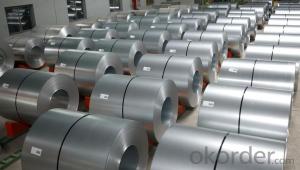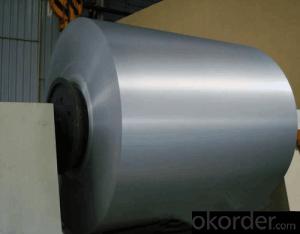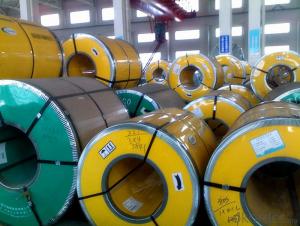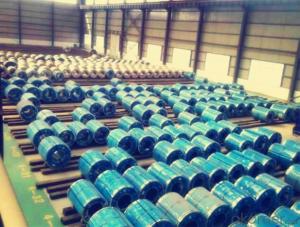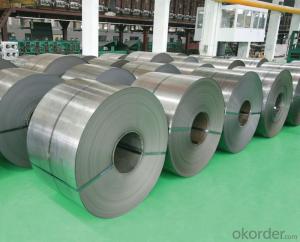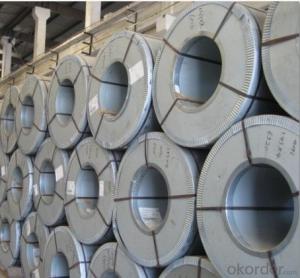Stainless Steel Coil Cold Rolled 304 2B With High Quality
- Loading Port:
- China main port
- Payment Terms:
- TT OR LC
- Min Order Qty:
- 400 m.t.
- Supply Capability:
- 5000 m.t./month
OKorder Service Pledge
OKorder Financial Service
You Might Also Like
Stainless Steel Coil Cold Rolled 304 With Good Quality
1.Structure of Stainless Steel Coil Cold Rolled 304 With Good Quality
Cold Rolled stainless steel Coil with good quality is one of the raw material of the cold
rolled stainless steel Coil, which can be used directly in many places. Stainless Steel
(Stainless Steel) is short for acid-proof Stainless Steel, resistant to weak corrosive
medium such as air, steam, water, or with a Stainless Steel grade.
2.Main Features of Prefabricated Steel Structure High Building Project
Polishing performance In today's society stainless steel products in production after
polishing the process commonly, when only a small number of products such as water
heaters, water dispenser tank don't need polishing. So this will require materials
polishing performance is very good. The factors influencing polishing performance
mainly include the following: 1) raw material surface defects. Such as scratch, pitting,
pickling, etc. (2) raw material problem. Hardness is too low, easy when polishing cast
light (BQ), and the hardness is too low, the surface easily when deep drawing appear
orange peel phenomenon, which affects the BQ. Relatively high hardness of BQ
is good. (3) after deep drawing products, great deformation area surface will be a
small black spots and RIDGING, thus affecting the BQ.
3. Stainless Steel Coil Cold Rolled 304 With Good Quality Images


4. Stainless Steel Coil Cold Rolled 304 With Good Quality Specification
The word "stainless steel" is not merely refers to a pure stainless steel, but said more than
one hundred kinds of stainless steel industry, the development of each stainless steel has
good performance in their specific applications. The key to the success of the first is to
make clear purpose, and then determine the correct material. Related to architectural
construction applications usually only six types of steel. They contain 17 ~ 22% chromium,
good steel contains nickel. Add molybdenum can further improve the atmospheric
corrosion resistance, especially containing chloride atmospheric corrosion resistance.
Stainless steel often according to the state of organization can be divided into: martensite
steel, ferritic steel, austenitic steel, austenitic (two-phase) - ferrite stainless steel and
precipitation hardening stainless steel, etc. In addition, according to ingredients can be
divided into: chromium stainless steel, chromium nickel stainless steel and chromium
manganese nitrogen stainless steel, etc.
5. Applications of Stainless Steel Coil 304 With Good Quality
1. Kitchenware: tableware, cookware, Stoves…
2. Food packing: storage cans, food containers…
3. Construction: bridge, roofing, wall, decoration, bathroom accessories…
4. Precision instruments: electrical products, aerospace…
5. Others: automotive parts, machine building, chemical processing, farming…
6.FAQ of Stainless Steel Coil 304 With Good Quality
We have organized several common questions for our clients,may help you sincerely:
①How about your company?
A world class manufacturer & supplier of castings forging in carbon steel and alloy steel,
is one of the large-scale professional investment casting production bases in China,
consisting of both casting foundry forging and machining factory. Annually more than 800
0 tons Precision casting and forging parts are exported to markets in Europe,America an
d Japan. OEM casting and forging service available according to customer’s requirement.
②How to guarantee the quality of the products?
We have established the international advanced quality management system,every link
from raw material to final product we have strict quality test;We resolutely put an end to
unqualified products flowing into the market. At the same time, we willprovide necessary
follow-up service assurance.
③How is the packaging and delivery?
Standard export packing (Coil: waterproof paper + protective steel ring; Circle: wooden
box), or as your requirement and the delivery term is based on the project.
④How long can we receive the product after purchase?
In the purchase of product within 20 working days, We will arrange the factory delivery as
soon as possible. The specific time of receiving is related to the state and position of
customers. Commonly 20 to 40 working days can be served.
- Q: Are stainless steel strips available in different colors?
- No, stainless steel strips are typically only available in their natural silver color.
- Q: Are stainless steel strips suitable for chemical reactors?
- Yes, stainless steel strips are suitable for chemical reactors. Stainless steel is a popular material choice for chemical reactors due to its excellent corrosion resistance properties. It is resistant to many corrosive chemicals, including acids, bases, and salts, making it highly suitable for use in various chemical processes. Stainless steel strips offer good structural strength, thermal stability, and durability, making them an ideal choice for constructing the shell and internal components of chemical reactors. Additionally, stainless steel is easy to clean and maintain, which is crucial in ensuring the integrity and efficiency of the chemical reactor. Overall, stainless steel strips are a reliable and suitable material for chemical reactors, providing the necessary resistance and performance required for handling various chemical reactions.
- Q: Are stainless steel strips suitable for jewelry making?
- Indeed, stainless steel strips prove to be an ideal option for crafting jewelry. This material, known for its durability and versatility, exhibits remarkable resistance against tarnishing, rust, and corrosion, thus ensuring the longevity of the jewelry. Moreover, stainless steel possesses hypoallergenic properties, rendering it suitable for individuals with sensitive skin or allergies to metals. The flexibility of stainless steel strips facilitates their manipulation into diverse jewelry designs, encompassing rings, bracelets, necklaces, and earrings. Furthermore, stainless steel frequently serves as a cost-effective substitute for pricier metals such as silver or gold, enabling those with a desire for high-quality jewelry to acquire it at a more affordable price.
- Q: Are stainless steel strips suitable for heat exchanger tubes?
- Yes, stainless steel strips are suitable for heat exchanger tubes. Stainless steel is known for its excellent corrosion resistance and heat resistance properties, making it an ideal material for heat exchanger applications. Stainless steel strips offer high strength, durability, and resistance to high temperatures, making them suitable for use in heat exchanger tubes. Additionally, stainless steel is easy to clean and maintain, ensuring the long-term performance and reliability of the heat exchanger.
- Q: Are 111 stainless steel strips suitable for high-temperature furnaces?
- No, 111 stainless steel strips are not suitable for high-temperature furnaces.
- Q: What are the common uses of stainless steel strips in the textile industry?
- Stainless steel strips are widely used in the textile industry for various purposes due to their exceptional properties and characteristics. One common use of stainless steel strips in this industry is as reinforcement in textile belts and conveyor systems. These strips help to enhance the strength and durability of the belts, allowing them to withstand heavy loads and continuous operation without any deformation. Another common use of stainless steel strips is in the production of textile machinery components. These strips are used to manufacture various parts such as guide rails, needle plates, and cutting blades. Stainless steel's corrosion resistance and high temperature resistance make it ideal for these applications, ensuring a long lifespan and reliable performance of the machinery. Stainless steel strips are also utilized in the production of textile molds and dies. These molds are used for processes like fabric embossing or printing, where stainless steel strips provide excellent heat transfer and stability. The high tensile strength of stainless steel ensures that the molds can withstand the pressure and stress exerted during the manufacturing process. Moreover, stainless steel strips find application in textile weaving and knitting machines. They are used as wire guides, tensioning devices, and reed hooks, providing smooth and accurate movement of yarns during the weaving or knitting process. The corrosion resistance of stainless steel ensures that the strips do not degrade over time, maintaining their functionality and reliability. In addition, stainless steel strips are employed in textile dyeing and finishing processes. These strips are used as clips or pins to secure the fabric in place during dyeing or finishing, ensuring that it does not unravel or get distorted. Stainless steel's resistance to chemicals and high temperatures makes it suitable for these applications, as it can withstand the harsh conditions of the dyeing and finishing processes. Overall, stainless steel strips play a crucial role in the textile industry, providing strength, durability, and reliability in various applications. Their corrosion resistance, high temperature resistance, and excellent mechanical properties make them a preferred material for reinforcing belts, manufacturing machinery components, producing molds, and facilitating various processes in the textile manufacturing sector.
- Q: Can 111 stainless steel strips be coated with anti-corrosion paints?
- Yes, 111 stainless steel strips can be coated with anti-corrosion paints. Stainless steel is generally resistant to corrosion, but applying an additional layer of anti-corrosion paint can provide added protection against environmental factors and extend the lifespan of the strips.
- Q: What are the typical tolerance levels for stainless steel strips?
- The typical tolerance levels for stainless steel strips can vary depending on the specific industry and application. However, common tolerance ranges for thickness can be around +/- 0.001 to 0.005 inches, for width it can be +/- 0.010 to 0.020 inches, and for length it can be +/- 0.020 to 0.040 inches. These ranges may vary further based on the specific requirements and standards set by manufacturers and customers.
- Q: Are 111 stainless steel strips suitable for desalination plants?
- Yes, 111 stainless steel strips are suitable for desalination plants. Stainless steel is a common material used in desalination plants due to its excellent corrosion resistance properties. The 111 stainless steel grade, also known as AISI 316L, is particularly well-suited for desalination plants as it exhibits high resistance to corrosion in chloride environments. This grade of stainless steel is also highly resistant to pitting and crevice corrosion, which are common issues in desalination plants due to the presence of saltwater. Additionally, 111 stainless steel strips have good strength and durability, making them suitable for use in the harsh operating conditions of desalination plants. Overall, 111 stainless steel strips are a reliable and suitable choice for desalination plants due to their corrosion resistance, strength, and durability.
- Q: Can stainless steel strips be stamped or engraved?
- Certainly! Stamping or engraving stainless steel strips is indeed possible. Stainless steel possesses great adaptability, enabling it to be effortlessly stamped or engraved with diverse patterns, logos, letters, or numbers. The process of stamping entails the application of pressure on the steel strip using a die, resulting in the formation of a distinct shape or pattern. Conversely, engraving involves the removal of material from the surface to craft a design. Both techniques offer the opportunity to enhance stainless steel strips with decorative or practical elements, rendering them highly suitable for an extensive array of applications across various industries, including automotive, aerospace, electronics, and jewelry.
Send your message to us
Stainless Steel Coil Cold Rolled 304 2B With High Quality
- Loading Port:
- China main port
- Payment Terms:
- TT OR LC
- Min Order Qty:
- 400 m.t.
- Supply Capability:
- 5000 m.t./month
OKorder Service Pledge
OKorder Financial Service
Similar products
Hot products
Hot Searches
Related keywords
